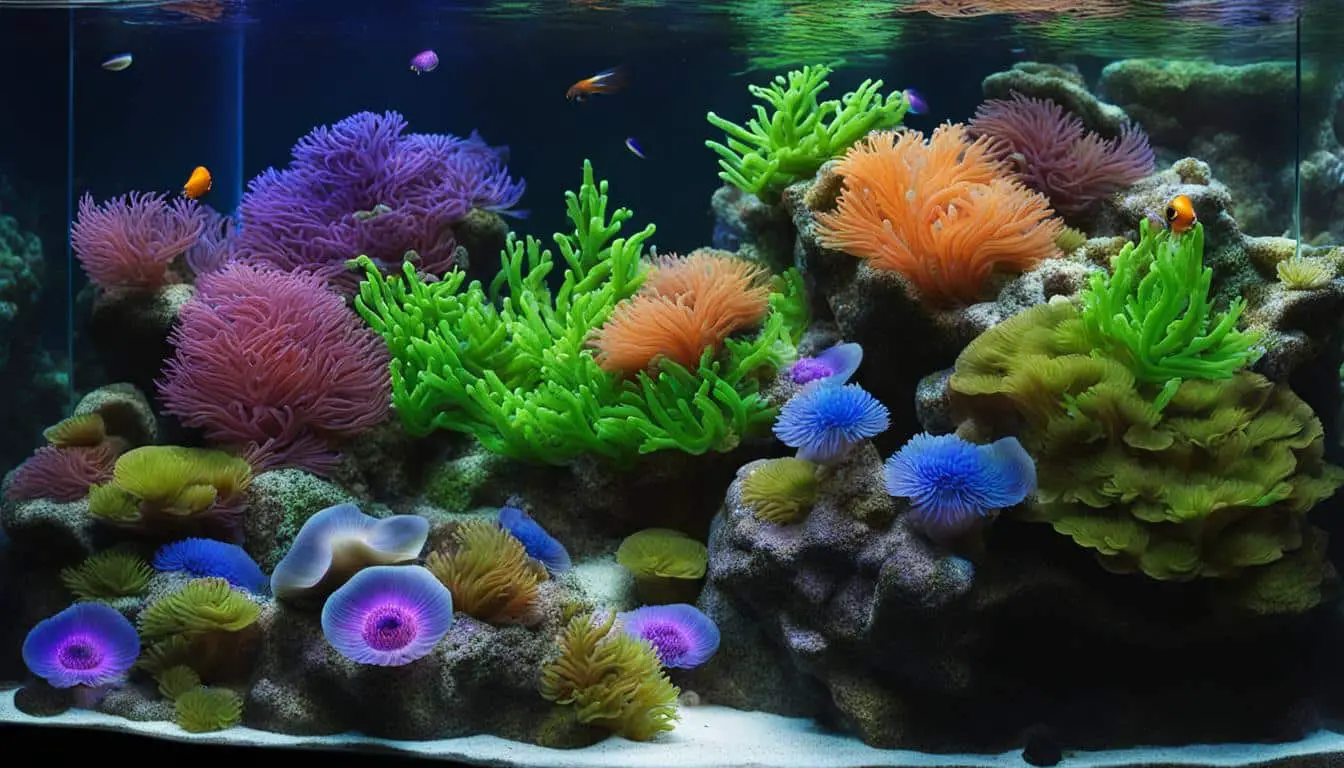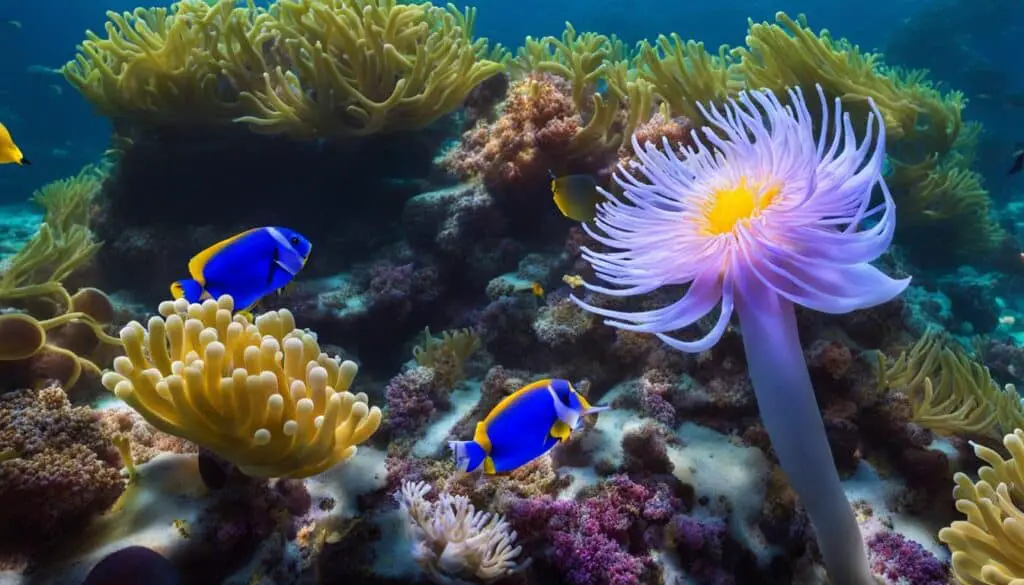Mastering Anemone Care: A Comprehensive Aquarium Guide

Sea anemones, also known as anemones, are predatory animals that can be challenging to keep in an aquarium. They belong to the phylum Cnidaria and are related to corals, jellyfish sizes, and hydra. Anemones have specific needs that can affect the overall health of your aquarium ecosystem. They have a columnar trunk topped by an oral disk with tentacles and a central mouth. Anemones are primarily predatory and use their stinging cells to paralyze prey. Some species can cause severe injuries. Anemones also have a symbiotic relationship with single-celled organisms like zooxanthellae, which provide oxygen and glucose through photosynthesis.
It is essential to ensure proper tank conditions, including matured water with stable parameters and high water quality. Anemones require moderate water flow and a high degree of dissolved oxygen. It is crucial to research the specific requirements of each anemone species before introducing them into your tank.
Key Takeaways:
- Anemones are predatory animals that belong to the phylum Cnidaria.
- They have specific needs that can affect the overall health of your aquarium ecosystem.
- Anemones use their stinging cells to paralyze prey and can cause severe injuries.
- Anemones have a symbiotic relationship with single-celled organisms like zooxanthellae.
- Proper tank conditions, including matured water and stable parameters, are crucial for anemone health.
Creating the Right Environment for Anemones in Your Aquarium
Different species of anemones have specific environmental needs. To ensure the well-being of your anemones, it is crucial to create the right tank setup and conditions that mimic their natural habitat.
Substrate and Tank Setup
When it comes to the substrate, some anemones prefer a rocky surface, while others thrive on a soft substrate, such as sand. Research the specific requirements of the anemone species you want to keep and provide the appropriate substrate to meet their needs.
In terms of tank setup, maintain a clean environment with little to no debris. Anemones require stable water parameters, including a pH of around 8.2, to ensure their health. Additionally, aim for a consistent temperature of around 77℉, as anemones are sensitive to temperature fluctuations.
Water Flow and Lighting
Anemones thrive in moderate water movement that mimics their natural habitat. Consider using a powerhead or wavemaker to provide the right amount of flow in your tank. However, be cautious not to create excessive turbulence that may stress your anemones.
Proper lighting is also essential for anemones. They rely on photosynthesis to receive nutrients from symbiotic zooxanthellae. Research the lighting requirements of the specific anemone species you have and provide the appropriate intensity and spectrum to support their photosynthetic needs.

By creating the right environment for your anemones, you can ensure their well-being and promote their overall health. The table below summarizes the key points to consider when setting up your anemone aquarium:
| Aspect | Considerations |
|---|---|
| Substrate | Research specific requirements for your anemone species. Some prefer rocks, while others need a soft substrate like sand. |
| Tank Setup | Maintain a clean environment with stable water parameters, including a pH of around 8.2, and a consistent temperature of 77℉. |
| Water Flow | Provide moderate water movement to mimic their natural habitat. Avoid excessive turbulence. |
| Lighting | Research the specific lighting requirements of your anemone species. Provide the appropriate intensity and spectrum. |
Feeding and Care for Healthy Anemones
Proper feeding and care are crucial for maintaining the health and vitality of your anemones in your saltwater aquarium. Anemone Care Aquarium Guide creatures that require regular feeding to ensure they receive adequate nutrition. While they may obtain some nutrients from the water and tank debris, it is recommended to feed them meaty foods at least twice a month.
Anemones have a unique feeding behavior. To feed them, place small scraps of food near their mouth, and they will react by taking it in. Meaty foods like scallops, clams, and mussels are ideal options for anemone feeding. However, it’s important to note that anemones may not eat at every feeding, as they may not always be hungry.
In addition to regular feeding, maintaining good water quality is essential for the overall health of anemones. Ensure that your tank conditions, including water parameters and quality, are stable and appropriate for anemones. Monitoring their behavior and appearance is also crucial for detecting any signs of poor health, such as shrinkage or paleness, and taking prompt action.
Key points for feeding and care:
- Feed anemones meaty foods like scallops, clams, and mussels twice a month.
- Place small food scraps near their mouth for feeding.
- Monitor their behavior and appearance for signs of poor health.
- Maintain stable water parameters and high water quality.
By providing regular feeding and proper care, you can ensure that your anemones thrive in your aquarium, adding beauty and uniqueness to your underwater world.

| Feeding Tips | Care Tips |
|---|---|
| Anemones require regular feeding of meaty foods like scallops, clams, and mussels. | Monitor their behavior and appearance for signs of poor health, such as shrinkage or paleness. |
| Place small scraps of food near their mouth and observe their feeding response. | Maintain stable water parameters and high water quality for the overall health of anemones. |
| Feed anemones at least twice a month to ensure they receive adequate nutrition. | Research the specific requirements of each anemone species for optimal care. |
Conclusion
As an expert in marine biology, I understand the challenges of keeping anemones in a saltwater aquarium. However, with the right knowledge and care, you can ensure the health and well-being of these fascinating creatures. By following the tips outlined in this guide, you can create an optimal environment for your anemones and enjoy their beauty in your aquarium.
Remember, Anemone Care Aquarium Guide research is key. Each species of anemone has specific requirements, so take the time to understand their needs and provide the appropriate tank conditions. From the type of substrate to the lighting and water flow, every factor plays a role in their overall health.
In addition, proper feeding and monitoring are crucial. Anemone Care Aquarium Guide and require regular feeding with meaty foods. Keep an eye on their behavior and appearance, as this can indicate their health condition. If you notice any signs of poor health, such as shrinkage or paleness, take immediate action to address the issue.
By implementing these Anemone Care Aquarium Guide, you can create a thriving and vibrant aquarium. The beauty and uniqueness that anemones bring to your tank are well worth the effort. So, invest in proper care, attention, and research, and enjoy the wonders of these mesmerizing creatures.
FAQ
What are the specific needs of anemones in an aquarium?
Anemones require matured water with stable parameters, high water quality, moderate water flow, and a high degree of dissolved oxygen. They also need clean water with little to no debris, a stable pH of around 8.2, and a steady temperature of around 77℉. Anemones rely on photosynthesis and require appropriate lighting. Each species may have different lighting requirements, so it is crucial to research and provide the right amount of light for your anemones.
How often should I feed my anemones?
Anemones should be fed twice a month to ensure they receive adequate nutrition. They feed on meaty foods such as scallops, clams, and mussels. Place small scraps of food near their mouth, and they will react by taking it in. However, don’t worry if they don’t eat at every feeding, as they may not always be hungry.
What should I do if my anemones show signs of poor health?
If your anemones show signs of poor health, such as shrinkage or paleness, it is essential to monitor their behavior and appearance closely. Poor water quality or improper tank conditions can be a common cause of health issues. Ensure the water parameters are stable, the lighting is appropriate, and the anemones are being fed adequately. If the health issues persist, consult with an aquarium expert or a veterinarian who specializes in aquatic animals.



